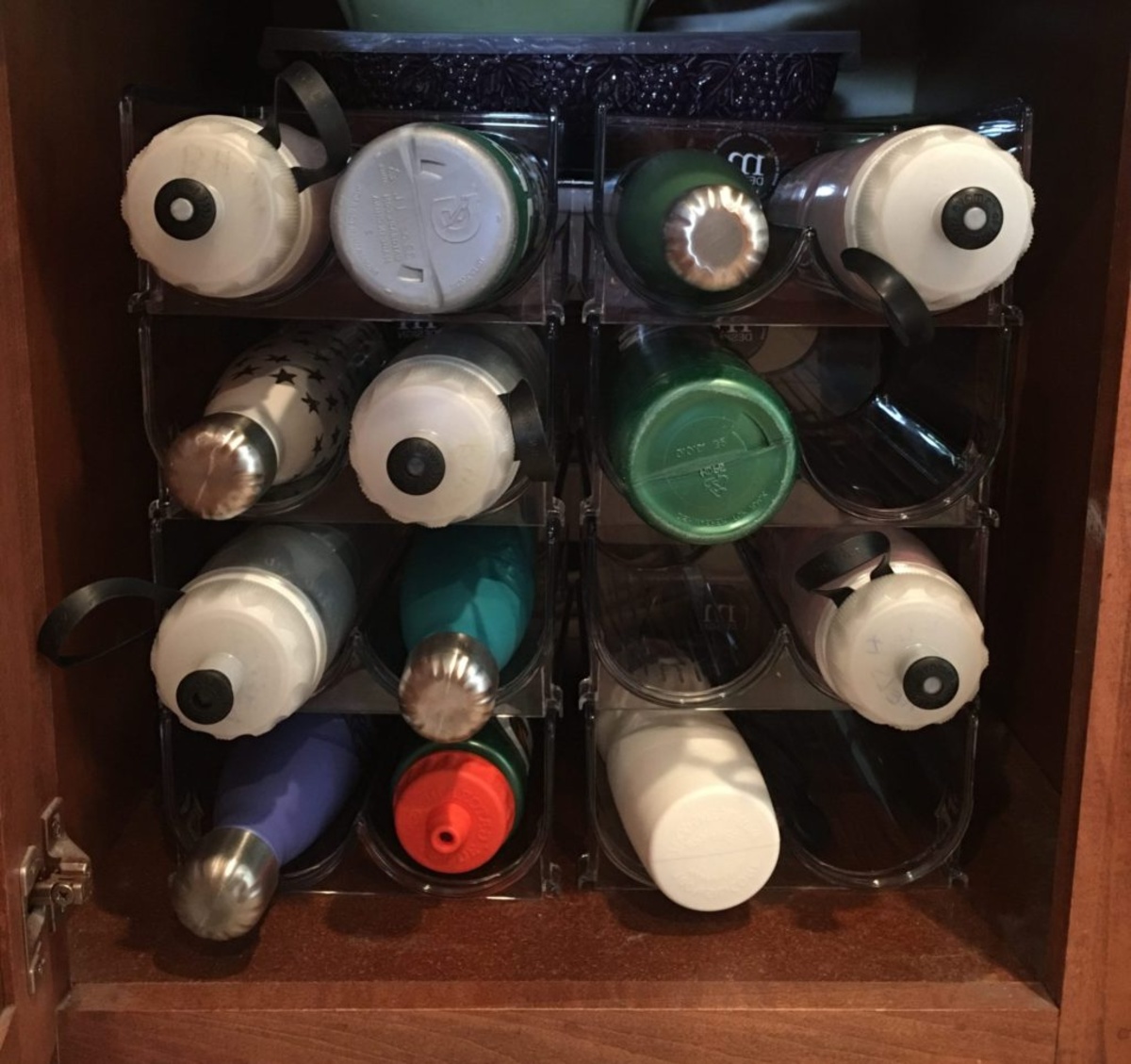Home>Renovation & DIY>Home Renovation Guides>How To Organize A Reseller Inventory


Home Renovation Guides
How To Organize A Reseller Inventory
Published: March 2, 2024
Learn how to efficiently organize your reseller inventory with our comprehensive home renovation guides. Maximize your profits and streamline your operations today!
(Many of the links in this article redirect to a specific reviewed product. Your purchase of these products through affiliate links helps to generate commission for Storables.com, at no extra cost. Learn more)
Understanding Your Reseller Inventory Needs
Understanding your reseller inventory needs is the first step in effectively organizing your stock. It's essential to have a clear understanding of the types of products you sell, the demand for each product, and the frequency of sales. By analyzing your sales data, you can identify your best-selling items and prioritize their storage and accessibility. Additionally, consider the seasonality of your products and any upcoming trends that may impact your inventory needs. This understanding will guide you in making informed decisions about how to best organize and manage your reseller inventory.
Key Takeaways:
- Understand your best-selling products and organize your inventory based on demand, seasonality, and trends to efficiently manage your reseller inventory.
- Utilize inventory management software and implement quality control measures to streamline operations, enhance customer satisfaction, and maintain a well-organized reseller inventory.
Read more: How To Organize Inventory
Sorting and Categorizing Your Products
Sorting and categorizing your products is crucial for efficient inventory management. Start by sorting your products into broad categories based on their type, size, and usage. For example, if you're a reseller of electronic gadgets, you might categorize your products into sections such as smartphones, tablets, accessories, and miscellaneous parts. Once you have these broad categories, further categorize the products within each section. This could involve organizing by brand, model, or specific features. Utilize clear labeling and signage to ensure that each category is easily identifiable.
To streamline the sorting and categorizing process, consider using color-coded labels or tags for different product categories. This visual aid can significantly speed up the retrieval process and minimize errors when restocking or fulfilling orders. Additionally, invest in storage containers, shelves, or racks that are specifically designed to accommodate the different categories of products. This will not only make it easier to locate items but also help prevent damage or misplacement.
Another effective method for sorting and categorizing is to establish a SKU (Stock Keeping Unit) system. Assigning a unique SKU to each product allows for easy identification and tracking. This system can be alphanumeric and may include details such as product type, brand, size, and color. Implementing a SKU system can greatly enhance the efficiency of inventory management, making it simpler to monitor stock levels and locate specific items when needed.
In addition to physical sorting, consider creating a digital inventory database that mirrors the categorization system used in your physical storage space. This database should include detailed information about each product, such as SKU, description, quantity, and location within your storage area. By keeping both physical and digital records organized and synchronized, you can ensure a seamless and accurate inventory management process.
Implementing a Storage System
Implementing an effective storage system is essential for maintaining an organized and efficient reseller inventory. Begin by assessing the available space in your storage area and determining the most suitable storage solutions for your products. Utilize a combination of shelving units, storage bins, racks, and cabinets to maximize the use of vertical and horizontal space. Adjustable shelving units are particularly beneficial as they can be customized to accommodate products of varying sizes.
Consider the nature of your products when selecting storage containers. For fragile or delicate items, opt for sturdy, impact-resistant bins or containers to minimize the risk of damage during handling and storage. Additionally, for products that require protection from dust, moisture, or light, invest in sealed containers or cabinets to preserve their quality.
To optimize accessibility, arrange your storage system in a logical manner. Place frequently accessed items at eye level or within easy reach, while reserving higher or lower shelves for less frequently used products. This arrangement can significantly reduce the time and effort required to locate and retrieve items, enhancing overall operational efficiency.
Furthermore, labeling is a crucial aspect of an effective storage system. Clearly label each storage area, shelf, or bin with the corresponding product category or SKU. Use large, legible fonts and high-contrast colors to ensure that labels are easily visible. Consider incorporating barcode labels or QR codes for rapid scanning and identification, especially if you plan to integrate inventory management software.
Lastly, maintain a clean and organized storage environment by implementing regular cleaning and maintenance schedules. This includes removing any obsolete or damaged inventory, conducting periodic inventory audits, and reorganizing the storage layout as needed. By consistently upholding a well-maintained storage system, you can ensure that your reseller inventory remains orderly and easily manageable.
Utilizing Inventory Management Software
Utilizing inventory management software can revolutionize the way you handle your reseller inventory. This software offers a range of features designed to streamline inventory tracking, order fulfillment, and overall management. When selecting inventory management software, look for a solution that aligns with the specific needs of your reseller business. Consider features such as barcode scanning, real-time inventory updates, customizable reporting, and integration capabilities with e-commerce platforms.
One of the key benefits of inventory management software is its ability to provide real-time visibility into your stock levels. With accurate and up-to-date information on inventory quantities, you can make informed decisions regarding restocking, purchasing, and order fulfillment. This real-time visibility also enables you to identify slow-moving or excess stock, allowing for proactive measures to optimize inventory turnover.
Furthermore, inventory management software often includes automated reorder point alerts and stock level notifications. By setting up these alerts, you can ensure that you never run out of essential products and minimize the risk of stockouts. This proactive approach to inventory replenishment can enhance customer satisfaction by reducing the likelihood of backorders and delayed shipments.
Another valuable feature of inventory management software is its ability to generate comprehensive reports and analytics. These reports can provide insights into sales trends, product performance, and inventory turnover rates. By analyzing this data, you can make data-driven decisions to optimize your product offerings, pricing strategies, and overall inventory management processes.
Integration with e-commerce platforms is also a crucial aspect of inventory management software. Seamless integration allows for automatic synchronization of inventory levels across your online sales channels, reducing the likelihood of overselling and order fulfillment errors. This integration can also facilitate the efficient processing of orders, as inventory updates are automatically reflected in your e-commerce platform.
In addition to these features, many inventory management software solutions offer mobile accessibility, enabling you to manage your inventory on the go. This flexibility is particularly beneficial for resellers who operate in multiple locations or attend trade shows and events. With mobile access, you can quickly check stock levels, fulfill orders, and make inventory adjustments from any location with internet connectivity.
Overall, the utilization of inventory management software can significantly enhance the efficiency, accuracy, and overall organization of your reseller inventory. By leveraging the advanced capabilities of this software, you can streamline your inventory management processes and focus on growing your reseller business.
Setting Up a Reordering System
Setting up a reordering system is crucial for maintaining optimal stock levels and ensuring that you never run out of essential products. The first step in establishing a reordering system is to determine the reorder point for each of your products. The reorder point is the inventory level at which you need to place a new order to replenish stock before it runs out. To calculate the reorder point, consider factors such as lead time (the time it takes for a new order to arrive), average daily sales, and safety stock requirements.
Once you have identified the reorder points for your products, it's essential to establish a clear and efficient process for generating purchase orders. This process may involve utilizing your inventory management software to automatically generate purchase orders when inventory levels reach the reorder points. Alternatively, you can create a manual system that triggers purchase orders based on regular inventory checks or predetermined reorder thresholds.
In addition to defining the reorder points and purchase order generation process, it's important to establish relationships with reliable suppliers and vendors. Maintaining open communication with your suppliers and negotiating favorable terms can ensure that you have access to timely and cost-effective replenishments. Consider factors such as lead times, minimum order quantities, and supplier reliability when selecting and managing your supplier relationships.
Furthermore, consider implementing a just-in-time (JIT) inventory approach as part of your reordering system. JIT inventory management involves receiving goods only as they are needed, minimizing excess inventory and storage costs. By synchronizing your reordering system with customer demand and sales patterns, you can optimize inventory turnover and reduce the risk of overstocking.
Regularly review and adjust your reorder points based on changes in demand, seasonality, and supplier lead times. As your reseller business evolves, it's essential to adapt your reordering system to align with shifting market dynamics and customer preferences. By staying proactive and responsive to changes in the market, you can maintain a well-balanced inventory and avoid stockouts or excess inventory accumulation.
By setting up a robust reordering system, you can effectively manage your reseller inventory and ensure that you always have the right products available to meet customer demand. This proactive approach to inventory replenishment can enhance operational efficiency and contribute to the overall success of your reseller business.
Read more: How To Organize Parts Inventory
Establishing Quality Control Measures
Quality control is a critical aspect of managing a reseller inventory, as it ensures that the products you offer meet the expected standards of quality and reliability. By establishing robust quality control measures, you can uphold customer satisfaction, minimize returns, and safeguard your reputation as a reseller.
One fundamental step in establishing quality control measures is to define clear quality standards for the products you resell. This involves understanding the specific attributes and characteristics that define a high-quality product within your industry. Consider factors such as material quality, functionality, durability, and aesthetic appeal. By outlining these standards, you provide a clear benchmark for evaluating the quality of incoming inventory.
Upon receiving new inventory, implement thorough inspection procedures to assess the quality of each product. This may involve conducting visual inspections, functional tests, or spot checks to ensure that the products meet your defined quality standards. Create detailed inspection checklists that cover all relevant quality criteria, and train your staff to perform consistent and meticulous evaluations.
Incorporate feedback mechanisms into your quality control process by encouraging customer feedback and monitoring product performance. Customer reviews and feedback can provide valuable insights into the quality of your products and highlight any recurring issues or concerns. By actively seeking and addressing customer feedback, you demonstrate a commitment to continuous improvement and quality assurance.
Additionally, consider implementing a quality assurance program in collaboration with your suppliers. Establish open communication channels to address quality-related issues and work towards mutually beneficial solutions. By fostering a collaborative approach to quality control with your suppliers, you can mitigate quality discrepancies and build stronger partnerships based on shared quality objectives.
In the event of quality issues or product defects, have a clear protocol for managing returns, exchanges, or warranty claims. This process should be transparent, efficient, and customer-centric, aiming to resolve quality-related issues promptly and professionally. By demonstrating a proactive approach to addressing quality concerns, you can instill confidence in your customers and maintain a positive brand reputation.
Regularly review and refine your quality control measures based on feedback, industry developments, and changing customer expectations. Quality control is an ongoing process that requires adaptability and continuous improvement. By staying vigilant and responsive to quality-related matters, you can uphold the integrity of your reseller inventory and differentiate your business through a commitment to quality.
By establishing comprehensive quality control measures, you can instill confidence in your customers and maintain a reputation for delivering high-quality products. This proactive approach to quality assurance can contribute to customer loyalty, positive brand perception, and sustained success in the competitive reseller market.
Creating a Product Display and Packaging System
Creating an effective product display and packaging system is essential for showcasing your inventory in a visually appealing and organized manner. The presentation of your products can significantly influence customer perception and purchasing decisions. Here are key strategies for creating a compelling product display and packaging system:
1. Visual Merchandising:
Utilize visual merchandising techniques to create an engaging and aesthetically pleasing product display. Consider factors such as product arrangement, lighting, and signage to draw attention to featured items and highlight their key attributes. Use display fixtures such as shelves, racks, and stands to showcase products in an organized and accessible manner.
2. Brand Cohesion:
Ensure that your product display and packaging align with your brand identity and messaging. Consistent branding across your display and packaging reinforces brand recognition and fosters a cohesive customer experience. Incorporate your brand colors, logos, and visual elements into the design of your display and packaging materials.
Read more: How To Organize A Warehouse Inventory
3. Informational Signage:
Integrate informational signage or product cards within the display to provide relevant details about each item. This may include product descriptions, features, pricing, and any promotional offers. Clear and informative signage enhances the customer's understanding of the products and can influence purchase decisions.
4. Interactive Elements:
Incorporate interactive elements within the product display to encourage customer engagement. This could involve product demonstration stations, interactive digital displays, or sample stations, depending on the nature of your products. Interactive elements create a memorable and immersive shopping experience for customers.
5. Packaging Design:
Develop packaging designs that not only protect the products but also reflect the quality and value of the items. Consider using custom packaging that showcases your brand identity and enhances the unboxing experience for customers. Well-designed packaging can leave a lasting impression and contribute to customer satisfaction.
6. Eco-Friendly Packaging:
Incorporate eco-friendly packaging materials and practices into your packaging system to align with sustainable consumer preferences. Utilize recyclable, biodegradable, or reusable packaging options to minimize environmental impact and appeal to environmentally conscious customers.
Read more: How To Organize Your Poshmark Inventory
7. Product Segmentation:
Organize your product display and packaging system based on product segmentation and customer preferences. Group related items together and create themed displays to cater to specific customer needs or occasions. This segmentation can guide customers to relevant products and facilitate cross-selling opportunities.
8. Seasonal Displays:
Adapt your product display and packaging system to reflect seasonal or thematic promotions. Create seasonal displays that align with holidays, special events, or seasonal trends. This dynamic approach to product presentation keeps your inventory fresh and relevant to changing customer interests.
By implementing these strategies, you can create a captivating product display and packaging system that enhances the appeal of your inventory, reinforces your brand identity, and elevates the overall shopping experience for your customers. A well-executed product display and packaging system can contribute to increased sales, customer satisfaction, and brand loyalty.
Managing Returns and Exchanges
Managing returns and exchanges is an integral part of reseller inventory organization, as it directly impacts customer satisfaction and retention. Establishing a clear and customer-centric returns and exchanges policy is essential for providing a positive post-purchase experience. Here's a detailed overview of effective strategies for managing returns and exchanges:
-
Transparent Policy Communication:
Clearly communicate your returns and exchanges policy to customers through multiple channels, including your website, order confirmations, and packaging inserts. Provide detailed information about the eligibility criteria, timeframes, and procedures for initiating returns or exchanges. Transparency instills confidence in customers and sets clear expectations regarding the process. -
Streamlined Return Process:
Implement a streamlined and user-friendly return process to simplify the experience for customers. Offer multiple return options, such as in-store returns, mail-in returns, or online return requests. Provide pre-paid return labels or offer convenient drop-off locations to facilitate hassle-free returns. A seamless return process demonstrates a commitment to customer convenience and satisfaction. -
Flexible Exchange Options:
Offer flexible exchange options to accommodate customer preferences. Allow for exchanges for different sizes, colors, or alternative products within a reasonable timeframe. Providing flexibility in exchanges demonstrates a customer-centric approach and can lead to increased customer loyalty. -
Automated Return Authorization:
Utilize automated return authorization systems to expedite the return and exchange process. Implementing an automated system allows customers to initiate returns online, receive return authorizations promptly, and track the status of their returns. Automation reduces administrative burden and enhances the efficiency of handling return requests. -
Quality Inspection Protocols:
Upon receiving returned items, implement rigorous quality inspection protocols to assess the condition of the products. Conduct thorough inspections to determine whether returned items are eligible for resale. Clearly define criteria for acceptable returns and establish protocols for handling damaged or used items. -
Efficient Refund Processing:
Streamline the refund processing workflow to ensure timely and accurate reimbursements to customers. Implement efficient refund mechanisms that align with the original payment method used by customers. Prompt refunds demonstrate a commitment to customer satisfaction and can positively influence the overall post-purchase experience. -
Return Analytics and Feedback Analysis:
Leverage return analytics and customer feedback to identify trends, patterns, and opportunities for improvement. Analyze return reasons, product issues, and customer feedback to address recurring issues and enhance product quality. Utilize this data to make informed decisions about product assortment, quality control measures, and customer communication. -
Continuous Process Improvement:
Continuously evaluate and refine your returns and exchanges process based on customer feedback and industry best practices. Stay responsive to evolving customer needs and market trends, and adapt your policies and procedures accordingly. A commitment to continuous improvement demonstrates a dedication to providing an exceptional customer experience.
By implementing these strategies, you can effectively manage returns and exchanges, foster customer satisfaction, and build trust with your customer base. A well-managed returns and exchanges process can contribute to customer loyalty, positive brand perception, and sustained success in the competitive reseller market.
Conducting Regular Inventory Audits
Regular inventory audits are essential for maintaining the accuracy and integrity of your reseller inventory. Conducting thorough and systematic audits allows you to identify discrepancies, prevent stockouts or overstocking, and ensure that your inventory records align with the actual stock on hand. Here's a detailed overview of the key steps involved in conducting regular inventory audits:
-
Audit Schedule: Establish a consistent schedule for conducting inventory audits based on the size of your inventory, sales volume, and industry trends. Consider conducting audits on a monthly, quarterly, or annual basis, depending on the dynamics of your business. A regular audit schedule helps maintain ongoing visibility into your inventory levels and minimizes the risk of inventory discrepancies.
-
Physical Count: Initiate the audit process by conducting a comprehensive physical count of your inventory. This involves physically verifying the quantity of each product in stock and comparing it to the recorded inventory levels in your management system. Utilize barcode scanners or manual counting methods to ensure accuracy during the physical count.
-
Cyclic Audits: Implement cyclic auditing methods to continuously verify specific sections of your inventory on a rotating basis. Rather than conducting a full inventory count at once, divide your inventory into manageable sections and audit a different section during each audit cycle. This approach allows for ongoing verification of inventory accuracy without disrupting regular operations.
-
Spot Checking: In addition to scheduled audits, perform spot checks on specific products or inventory locations to validate the accuracy of your records. Spot checks involve randomly selecting items or areas for immediate verification, providing real-time insights into the precision of your inventory management.
-
Documentation and Record-Keeping: Maintain detailed documentation of audit results, including discrepancies, variances, and any identified issues. Record-keeping is crucial for tracking audit history, identifying trends, and implementing corrective actions. Documenting audit findings also facilitates compliance with regulatory requirements and internal quality standards.
-
Root Cause Analysis: Analyze the root causes of inventory discrepancies identified during audits. Determine whether discrepancies are attributed to data entry errors, shrinkage, supplier issues, or other factors. Identifying the root causes enables you to implement targeted solutions to prevent recurring discrepancies and enhance inventory accuracy.
-
Process Improvement: Use audit findings to drive process improvement initiatives within your inventory management system. Address any systemic issues or inefficiencies identified during audits, such as inaccurate recording practices, inadequate storage controls, or insufficient quality checks. Continuously refine your inventory management processes based on audit insights.
-
Training and Education: Provide training and education to your staff on effective inventory auditing practices and the importance of maintaining accurate inventory records. Ensure that your team members are proficient in using inventory management tools, conducting physical counts, and adhering to audit protocols. Well-trained staff contribute to the success of inventory audits.
-
Integration with Inventory Management Software: Leverage the capabilities of inventory management software to streamline the audit process. Utilize features such as batch scanning, automated reconciliation, and real-time data updates to enhance the efficiency and accuracy of inventory audits. Integration with software simplifies the audit workflow and minimizes manual errors.
-
Continuous Monitoring: Implement continuous monitoring mechanisms to track inventory movements and adjustments between audit cycles. Utilize real-time reporting and exception alerts to identify irregularities or discrepancies as they occur. Continuous monitoring complements regular audits and provides ongoing visibility into inventory accuracy.
By diligently conducting regular inventory audits and implementing the associated best practices, you can uphold the accuracy, reliability, and efficiency of your reseller inventory management. Regular audits serve as a proactive measure to identify and address inventory discrepancies, optimize operational processes, and maintain a competitive edge in the reseller market.
Use a digital inventory management system to keep track of your products, including details like quantity, pricing, and expiration dates. This will help you stay organized and avoid overstocking or running out of popular items.
Read more: How To Identify Hand Tools For Inventory
Implementing a Pricing Strategy
Implementing a pricing strategy is a fundamental aspect of managing a reseller inventory, as it directly influences sales, profitability, and market positioning. A well-defined pricing strategy takes into account various factors, including product costs, market demand, competitive pricing, and customer perceptions. Here's a comprehensive overview of the key considerations and best practices for implementing an effective pricing strategy for your reseller inventory:
-
Cost Analysis: Begin by conducting a thorough analysis of your product costs, including acquisition costs, shipping fees, storage expenses, and any additional overheads. Understanding the total cost of acquiring and maintaining inventory provides a foundation for setting profitable yet competitive prices.
-
Competitive Benchmarking: Research and analyze the pricing strategies of your competitors to gain insights into prevailing market prices, pricing trends, and value-added services offered by competitors. Benchmarking allows you to position your prices competitively while highlighting the unique value proposition of your products.
-
Value-Based Pricing: Consider adopting a value-based pricing approach, where the price is determined by the perceived value of the product to the customer. Assess the unique features, benefits, and quality of your products to justify premium pricing based on the value they deliver to customers.
-
Dynamic Pricing: Explore the implementation of dynamic pricing strategies that adjust prices based on real-time market conditions, demand fluctuations, and customer behavior. Dynamic pricing can optimize revenue by aligning prices with changing market dynamics and customer preferences.
-
Pricing Segmentation: Segment your inventory based on customer segments, product categories, or market niches, and tailor pricing strategies to each segment. This approach allows for targeted pricing adjustments to cater to the diverse needs and purchasing behaviors of different customer groups.
-
Promotional Pricing: Incorporate promotional pricing strategies, such as limited-time discounts, bundle offers, or seasonal promotions, to stimulate sales and create a sense of urgency among customers. Strategic promotions can drive customer engagement and accelerate inventory turnover.
-
Psychological Pricing: Leverage psychological pricing techniques, such as charm pricing (e.g., pricing products at $9.99 instead of $10), to influence customer perceptions and enhance price attractiveness. Psychological pricing can subtly influence purchasing decisions and create a perception of affordability.
-
Price Testing and Optimization: Implement price testing methodologies to assess the impact of different pricing strategies on sales volume, revenue, and customer response. Continuously optimize prices based on the results of price testing to maximize profitability and customer satisfaction.
-
Channel-Specific Pricing: Tailor pricing strategies to align with different sales channels, such as online marketplaces, e-commerce platforms, and physical retail locations. Channel-specific pricing accounts for varying cost structures and customer behaviors across different sales channels.
-
Monitoring and Adjustments: Regularly monitor pricing performance, sales trends, and customer feedback to identify opportunities for pricing adjustments. Stay responsive to market changes and customer preferences, and make proactive pricing adjustments to maintain competitiveness.
By implementing a well-crafted pricing strategy that considers cost analysis, market dynamics, and customer behavior, you can optimize the profitability of your reseller inventory while effectively meeting customer needs and expectations. A strategic pricing approach contributes to sustained sales growth, customer satisfaction, and competitive positioning in the reseller market.
Frequently Asked Questions about How To Organize A Reseller Inventory
Was this page helpful?
At Storables.com, we guarantee accurate and reliable information. Our content, validated by Expert Board Contributors, is crafted following stringent Editorial Policies. We're committed to providing you with well-researched, expert-backed insights for all your informational needs.












0 thoughts on “How To Organize A Reseller Inventory”